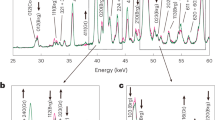Abstract
The thermal structure of the Earth's lowermost mantle—the D″ layer spanning depths of ∼2,600–2,900 kilometres1—is key to understanding the dynamical state and history of our planet. Earth's temperature profile (the geotherm) is mostly constrained by phase transitions, such as freezing at the inner-core boundary or changes in crystal structure within the solid mantle, that are detected as discontinuities in seismic wave speed and for which the pressure and temperature conditions can be constrained by experiment and theory. A recently discovered phase transition at pressures of the D″ layer2,3,4 is ideally situated to reveal the thermal structure of the lowermost mantle, where no phase transitions were previously known to exist. Here we show that a pair of seismic discontinuities observed in some regions of D″ can be explained by the same phase transition as the result of a double-crossing of the phase boundary by the geotherm at two different depths. This simple model can also explain why a seismic discontinuity is not observed in some other regions, and provides new constraints for the magnitude of temperature variations within D″.
This is a preview of subscription content, access via your institution
Access options
Subscribe to this journal
Receive 51 print issues and online access
$199.00 per year
only $3.90 per issue
Buy this article
- Purchase on Springer Link
- Instant access to full article PDF
Prices may be subject to local taxes which are calculated during checkout




Similar content being viewed by others
References
Bullen, K. E. Compressibility-pressure hypothesis and the Earth's interior. Mon. Not. R. Astron. Soc. Geophys. Suppl. 5, 355–368 (1949)
Murakami, M., Hirose, K., Sata, N., Ohishi, Y. & Kawamura, K. Phase transition of MgSiO3 perovskite in the deep lower mantle. Science 304, 855–858 (2004)
Oganov, A. R. & Ono, S. Theoretical and experimental evidence for a post-perovskite phase of MgSiO3 in Earth's D″ layer. Nature 430, 445–448 (2004)
Tsuchiya, T., Tsuchiya, J., Umemoto, K. & Wentzcovitch, R. M. Phase transition in MgSiO3 perovskite in the earth's lower mantle. Earth Planet. Sci. Lett. 224, 241–248 (2004)
Lay, T. & Helmberger, D. V. A shear velocity discontinuity in the lower mantle. Geophys. Res. Lett. 10, 63–66 (1983)
Wysession, M. et al. The Core-Mantle Boundary Region 273–298 (American Geophysical Union, Washington, DC, 1998)
Sidorin, I., Gurnis, M., Helmberger, D. V. & Ding, X. Interpreting D″ seismic structure using synthetic waveforms computed from dynamic models. Earth Planet. Sci. Lett. 163, 31–41 (1998)
Boehler, R. High-pressure experiments and the phase diagram of lower mantle and core constituents. Rev. Geophys. 38, 221–245 (2000)
Alfè, D., Gillan, M. J. & Price, G. D. Composition and temperature of the Earth's core constrained by combining ab initio calculations and seismic data. Earth Planet. Sci. Lett. 195, 91–98 (2002)
Thomas, C., Kendall, J. & Lowman, J. Lower-mantle seismic discontinuities and the thermal morphology of subducted slabs. Earth Planet. Sci. Lett. 225, 105–113 (2004)
Thomas, C., Garnero, E. J. & Lay, T. High-resolution imaging of lowermost mantle structure under the Cocos plate. J. Geophys. Res. 109, B08307 (2004)
Müller, G. The reflectivity method: A tutorial. Z. Geophys. 58, 153–174 (1985)
Stacey, F. Physics of the Earth 3rd edn, appendix G (Brookfield, Kenmore, Queensland, 1992)
Buffett, B. A. Estimates of heat flow in the deep mantle based on the power requirements for the geodynamo. Geophys. Res. Lett. 29, GL014649 (2002)
Christensen, U. R. & Tilgner, A. Power requirement of the geodynamo from ohmic losses in numerical and laboratory dynamos. Nature 429, 169–171 (2004)
Lithgow-Bertelloni, C. & Richards, M. A. The dynamics of Cenozoic and Mesozoic plate motions. Rev. Geophys. 36, 27–78 (1998)
Nakagawa, T. & Tackley, P. J. Effects of a perovskite-post perovskite phase change near the core-mantle boundary in compressible mantle convection. Geophys. Res. Lett. 31, L16611 (2004)
Aizawa, Y. et al. Temperature derivatives of elastic moduli of MgSiO3 perovskite. Geophys. Res. Lett. 31, L01602 (2004)
Dziewonski, A. M. & Anderson, D. L. Preliminary reference earth model. Phys. Earth Planet. Inter. 25, 297–356 (1981)
Kennett, B. L. N., Engdahl, E. R. & Buland, R. Constraints on seismic velocities in the Earth from travel times. Geophys. J. Int. 122, 108–124 (1995)
Acknowledgements
This collaboration was facilitated by the Meeting of Young Researchers in the Earth Sciences (MYRES) held in La Jolla, California, in August 2004. This work was supported by a grant from IGPP Los Alamos.
Author information
Authors and Affiliations
Corresponding author
Ethics declarations
Competing interests
The authors declare that they have no competing financial interests.
Rights and permissions
About this article
Cite this article
Hernlund, J., Thomas, C. & Tackley, P. A doubling of the post-perovskite phase boundary and structure of the Earth's lowermost mantle. Nature 434, 882–886 (2005). https://doi.org/10.1038/nature03472
Received:
Accepted:
Issue Date:
DOI: https://doi.org/10.1038/nature03472
This article is cited by
-
Sustaining Earth’s magnetic dynamo
Nature Reviews Earth & Environment (2022)
-
Geoneutrinos and geoscience: an intriguing joint-venture
La Rivista del Nuovo Cimento (2022)
-
Kinetics and detectability of the bridgmanite to post-perovskite transformation in the Earth's D″ layer
Nature Communications (2019)
-
Progress in numerical modeling of subducting plate dynamics
Science China Earth Sciences (2018)
-
Ultra-low velocity zone heterogeneities at the core–mantle boundary from diffracted PKKPab waves
Earth, Planets and Space (2017)
Comments
By submitting a comment you agree to abide by our Terms and Community Guidelines. If you find something abusive or that does not comply with our terms or guidelines please flag it as inappropriate.



